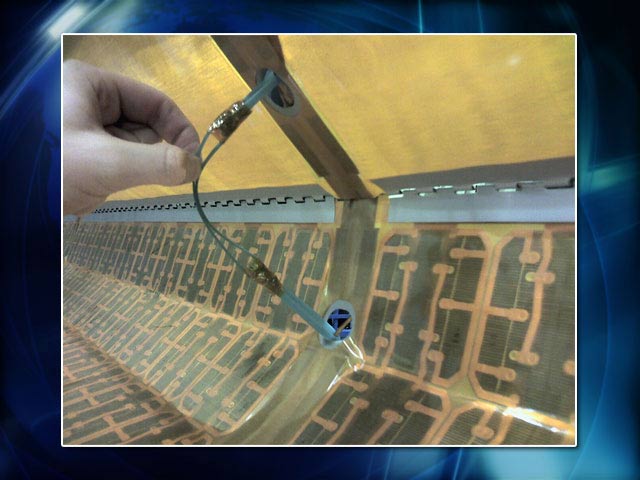How to Build Space Station-Saving Cuff Links

In 1970,the solution involved duct tape, a flight manual's cover, a plastic bag and asock.
Three yearslater, it was a nylon and mylar umbrella that was assembled with a sewingmachine. In 1985, although unsuccessful, the answer was two makeshiftflyswatters.
And onSaturday, should NASA proceed as planned, the success of its current mission willrely on six cuff links.
But it'snot like the 10 astronauts in space can rent the fasteners from the localtuxedo shop. To save the space station on which they all currently inhabit,they needed to assembletheir repair tools from the spare parts launched for just such anoccasion.
A rip inan array
Earlierthis week, after successfully repositioning a truss and solar array assembly toits permanent berth on the International Space Station (ISS), the crew of shuttle Discoveryand the outpost's own residents set about deploying the segments' pair ofpower-generating wings. The first array extended without issue, but as thesecond was almost at its full length, the station's commander halted the deployafter observinga tear that was forming mid-way along its 110-foot (33 meter) length.
The damage,which upon closer inspection was found to be two tears -- a 2.5-foot (0.7-meter)rip and another about one-third the size -- was a serious concern. The ISS wasalready at a power handicap as a faulty joint was preventing one set of itsarrays from rotating to track the Sun. Now, with the second set of arraysunable to extend completely, it too would be unable to follow thepower-providing rays of our nearest star. Although there was enough electricityto support its current configuration, without repair, the torn wing wasthreatening future expansion, including the long awaited launch of European andJapanese science labs.
Get the Space.com Newsletter
Breaking space news, the latest updates on rocket launches, skywatching events and more!
Flightscontrollers quickly went to work around the clock to develop a daring plan:using a 50-foot (15-meter) boom designed to inspect the shuttle for damage andthe station's own 50-foot robotic arm, an astronaut will be positioned at thesite of the tear, where he will attempt to clear a snagged guide wire believedto be the source of the damage, and then repair the torn hinge by insertingsplints, referred to as cuff links, to stabilize the array such that it can befully extended. Were it not enough that the boom has never been used for such apurpose, or that the astronauts were never trained for such a maneuver, thearray, though torn, will still be running a current such that it poses a lowbut real risk of shocking the spacewalker.
MacGyver'smission
Well beforeDiscovery launched to space on Oct. 23, STS-120 commander Pam Melroy dubbed oneof her six crewmates as the astronaut version of the resourceful TV characterMacGyver. Speaking of her mission specialist from the European Space Agency,Melroy recalled telling Paolo Nespoli to take all his tools with him to space.
"Iencouraged him to take one of everything because I am sure he's going to buildsomething in space with it."
As chancewould have it, Melroy would be partially right. Though Nespoli will supportScott Parazynski and Doug Wheelock during the spacewalk from his vantage pointinside, it was Discovery's pilot George Zamka along with ISS Expedition 16commander Peggy Whitson who were called upon on Thursday to exhibit theirinner-MacGyver.
Usingstrips of aluminum, a hole punch, a bolt connector and 66 feet (20 meters) ofwire, along with detailed instructions sent by mission control, the duoassembled half a dozen space station-saving cuff link contraptions. If allproceeds as planned, Parazynski, suspended at the end of the boom-arm assembly,will slip the cuff link-like tabs through holes in the array's blanket,enabling it to support the tension exerted when the solar wing is fullyextended.
Like thesock/duct tape/plastic bag solution that allowed a square-shaped carbon dioxidescrubber to fit in around hole aboard Apollo 13, the success of the cuff links won't be knownuntil they are installed, but those who worked to devise the fix are optimisticthat failure is not an option.
"We'refaced with a difficult situation," said experienced spacewalker DavidWolf. "I think we're onto a solution that should work and get us prettyclose to a permanently acceptable situation."
Howexactly does one assemble a space station saving cufflink from spare parts?Very carefully, as appears to be the case in the seven-partinstructions that were uplinked to the astronauts, complete with illustrationsfor key steps.
SPACE.com'slive coverage ofthe spacewalk begins Saturday morning at 5:00 a.m. EDT (0900 GMT).
- SPACE.com Video Interplayer: Delivering 'Harmony' with NASA's STS-120 Mission
- Looking Back on 50 Years of Spaceflight
- Complete Space Shuttle Mission Coverage
Copyright 2007 collectSPACE.com. All rights reserved.
Join our Space Forums to keep talking space on the latest missions, night sky and more! And if you have a news tip, correction or comment, let us know at: community@space.com.

Robert Pearlman is a space historian, journalist and the founder and editor of collectSPACE.com, a daily news publication and community devoted to space history with a particular focus on how and where space exploration intersects with pop culture. Pearlman is also a contributing writer for Space.com and co-author of "Space Stations: The Art, Science, and Reality of Working in Space” published by Smithsonian Books in 2018.In 2009, he was inducted into the U.S. Space Camp Hall of Fame in Huntsville, Alabama. In 2021, he was honored by the American Astronautical Society with the Ordway Award for Sustained Excellence in Spaceflight History. In 2023, the National Space Club Florida Committee recognized Pearlman with the Kolcum News and Communications Award for excellence in telling the space story along the Space Coast and throughout the world.









